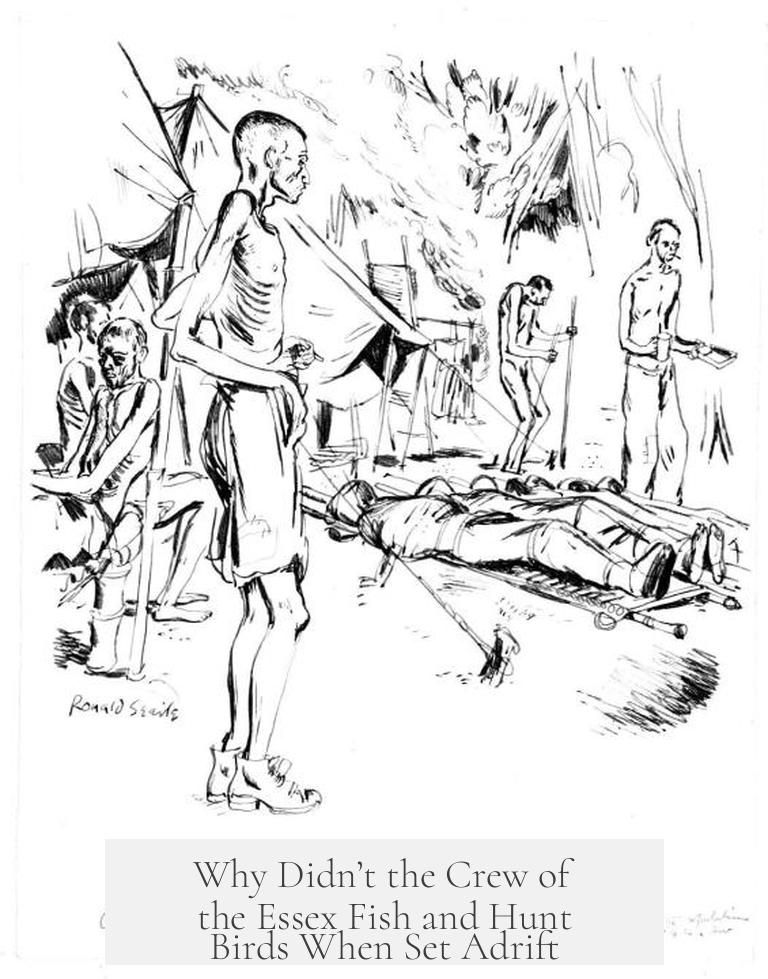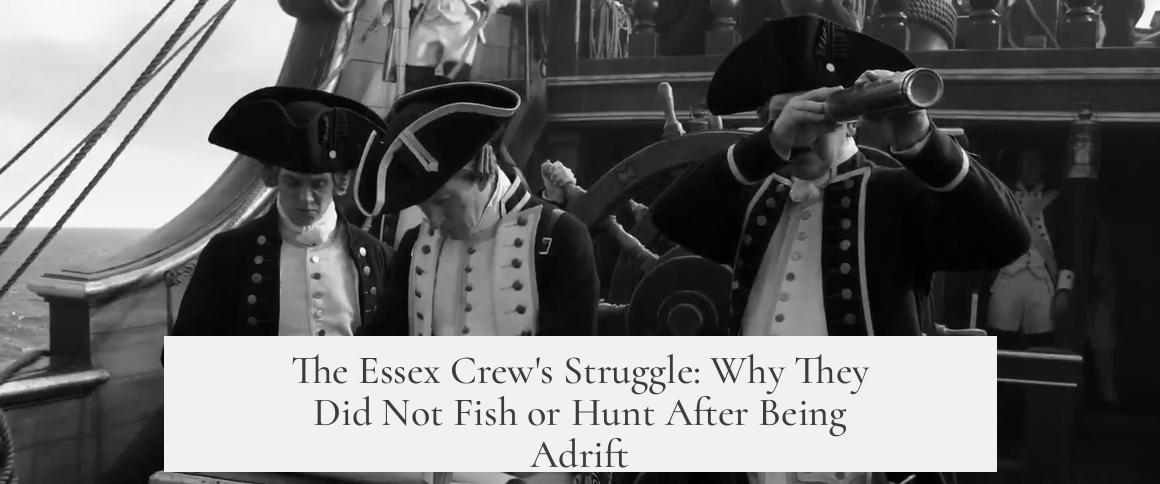The crew of the Essex did not fish or hunt birds while adrift because they were trapped in a vast, nutrient-poor part of the Pacific Ocean. This ocean region lacked fish and birds, making traditional survival tactics ineffective.
The Essex crew searched for the band of variable winds but sailed into a sterile zone of the Pacific. This region had very little marine life. Aside from occasional flying fish and gooseneck barnacles, the crew could not find sufficient aquatic food. Their efforts to catch fish failed repeatedly. This area was known among sailors for having scarce fish and bird populations.
Birds, a usual source of food for castaways, were nearly absent. The surrounding waters did not support a typical food chain. Without enough phytoplankton, the food base for fish, fish were also missing. Without fish, seabirds had no steady food supply and thus were seldom present. This ecosystem scarcity created dire conditions for the crew.
The crew’s only brief respite came at Henderson Island. Here, they found fresh water and birds to eat. However, these resources were limited. The island’s ecosystem was a rare exception in this nutrient-poor ocean stretch. Once the island’s supplies dwindled, the crew had to leave because it could not sustain them longer.
While stranded, the crew’s inability to fish or hunt was not from lack of effort or skill. It was due to the hostile natural environment where key survival food sources were almost absent.
- The ocean region was largely devoid of fish and birds.
- Scarce nutrients disrupted the natural food chain.
- Attempts to catch fish were mostly unsuccessful.
- Henderson Island briefly offered food and water but was unsustainable.
Why Didn’t the Crew of the Essex Fish and Hunt Birds When Set Adrift?

The tragic voyage of the Essex—and the fate of its crew—offers a bleak window into survival against overwhelming odds. An iconic foreshadowing of the perils faced by mariners stranded at sea, this 1820 whaling disaster left the crew adrift in one of the world’s most inhospitable marine environments. But why didn’t they simply fish or hunt birds for food? After all, fishing and hunting seem like the obvious choices for survival when you’re castaway on a small boat in the middle of the ocean.
The straightforward answer: the crew couldn’t fish or hunt because they were trapped in a famously barren patch of the Pacific Ocean, known as the Desolate Region.
The Desolate Region: Nature’s Great Desert at Sea
Most people imagine the vast Pacific as a teeming ecosystem overflowing with fish and seabirds, ready to be caught. But there’s a stark exception: an immense, oval-shaped part of the ocean that stretches from off the coast of Chile up to near the equator. This area earned the ominous nickname the Desolate Region.
In the mid-19th century, Matthew Fontaine Maury—often called the “Father of Modern Oceanography”—mapped this section of the Pacific. He relied on reports from whalers and mariners, many of whom noted a severe scarcity of lifeforms. He described these waters where “[m]ariners report few signs of life in sea or air.”
Why so barren? The ocean here is split into two distinct layers: a warm upper layer separated sharply from a cold bottom layer. This thermal barrier traps vital nutrients deep below the surface. Without those nutrients, phytoplankton—the tiny oceanic plants forming the base of the food chain—cannot thrive. Without phytoplankton, there’s no food for fish, and with no fish, birds lose their hunting grounds.
Imagine trying to grow a garden with no soil and no water; this oceanic “soil” is just as barren.
Getting Trapped: The Crew’s Journey into the Desolate Region
After the Essex was rammed and sunk by a sperm whale, the surviving crew sought the band of variable winds to sail back to civilization. This path, however, took them deep into the Desolate Region.
And this is why fishing or hunting birds wasn’t a practical option for the castaways. They were surrounded by nearly empty water. Their meager success was limited to gathering gooseneck barnacles clinging to the boat’s hull, and occasionally spotting flying fish, but those were rare and insufficient to sustain them.
Fishing is a basic survival skill for stranded sailors, but the crew of the Essex was undeniably “singularly unsuccessful” in catching these fish in an ocean zone devoid of them. The absence of sufficient prey meant luck and skill could not overcome reality.
Henderson Island: A Glimmer of Hope—and Why It Wasn’t Enough
After drifting for weeks in this desolate void, the Essex’s crew finally encountered Henderson Island, a small, isolated landmass. This offered a temporary reprieve. There were birds to hunt and fresh water to drink. Yet, even this sanctuary was a fragile oasis in the vast desert of the Pacific.
The island’s ecosystem was itself a isolated anomaly. Its food chain was precarious, lacking enough nutrients to support large or sustainable populations of fish and birds long-term. The crew quickly exhausted the available resources and realized Henderson could never support them indefinitely.
Out of necessity and desperation, they set off again, only to return to the barren sea.
So, What Can We Learn From the Essex Crew’s Ordeal?

Not all survival options are created equal—and sometimes the environment isn’t forgiving. The Essex crew didn’t fail because they lacked effort or skill. They failed because nature placed them in one of the loneliest, most life-starved spots on Earth.
Today, this story reminds mariners and adventurers that understanding local ecology isn’t just academic—it can be a matter of life and death. The ocean’s vastness is deceptive; some parts are rich ecosystems, others, like the Desolate Region, are oceanic wastelands.
Practical takeaway? If you ever find yourself stranded at sea (and let’s hope not), your success fishing and hunting will heavily depend on your location. Muddy water isn’t just harder to fish in—it might not have any fish at all.
In Conclusion: The Crew’s Harrowing Struggle
So why didn’t the crew of the Essex fish and hunt birds? Because they were trapped in an oceanic dead zone, a place where nutrient flow and lifeforms alike had dried up. This fact shaped their desperate, tragic journey.
Even when fate granted them the brief sanctuary of Henderson Island, nature’s limits quickly reasserted themselves. This isn’t just a story about survival against the odds; it’s a stark reminder of how profoundly the environment can limit human options, even for the bravest and most resourceful.
Would you know where to find your own “Desolate Region” if stranded? What survival choices would you make knowing life was scarce around you? It’s sobering—and crucial—to imagine the real, harsh boundaries nature can place between life and death in the open ocean.




